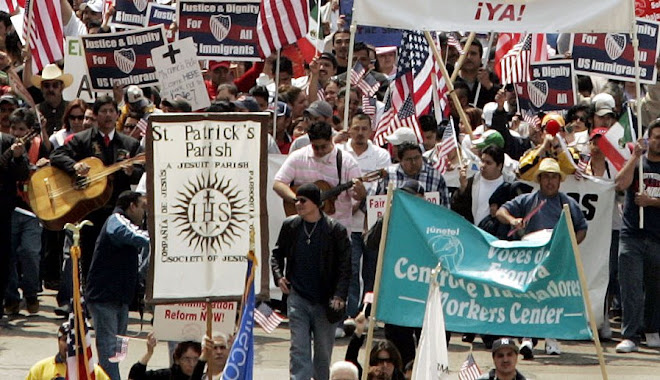
Por H. Nelson Goodson & Jon Higuera
KEARNEY, N.J. – Moises “Mory” Lamas, un peruano de 52 años, salió del Centro Correccional del Condado de Hudson como un hombre libre — por ahora — tras haber sido mantenido bajo custodia por 4 años 1/2 por Inmigración y Aduanas de EE.UU. (ICE), un brazo de Seguridad Interior.
Dice que no se le dio ninguna explicación de por qué lo liberaban, y no hizo preguntas.
En 1986 el Presidente Reagan firmó el Acta de Reforma a la Inmigración & Control, con una disposición de amnistía que trajo a casi 3 millones de inmigrantes fuera de las sombras.
Reagan declaró, “Las futuras generaciones estarán agradecidas de nuestros esfuerzos de recuperar humanamente el control de nuestras fronteras y, de ese modo, conservarán el valor de una de las posesiones más sagradas de nuestro pueblo, la ciudadanía norteamericana”.
Tanto Lamas como su esposa Ruth, quienes residen en el Oeste de Nueva York, N.J., ya han llenado las postulaciones para amnistía, pero estos trámites fueron suspendidos debido a una condena por delito menor en junio de 1986.
Su crimen: cuando todavía era indocumentado, fue acusado por posesión de una sustancia controlada.
SE DECLARÓ CULPABLE DE DELITO MENOR
Lamas, quien ha vivido en Estados Unidos por 26 años, estaba conduciendo con un conocido que llevaba 3.5 gramos de cocaína.
El conocido confesó a la policía que las drogas le pertenecían y que Lamas no sabía nada de ellas.
Bajo el consejo de su abogado y para evitar un juicio caro, Lamas se declaró culpable del cargo de delito menor y fue sentenciado a 364 días en prisión Se le requirió que cumpliera con menos de la mitad de ese tiempo. Nunca imaginó que esos cargos tendrían consecuencias con su estatus migratorio.
Adelantándose a 1999. Después de 13 años de vivir limpiamente, incluso siendo presidente del Local 13742 de United Steelworkers of America, su condena anterior lo puso a la vista de ICE por deportación. Esto comenzó después de que su esposa jurara como ciudadana de EE.UU. y posteriormente emitiera una petición para un ajuste de estatus para su marido.
En lugar de eso, las autoridades de inmigración usaron el “Acta de Reforma a la Inmigración Ilegal y Responsabilidad del Inmigrante” de 1996, aprobada por un Congreso controlado por los Republicanos y luego firmado en ley por el entonces Presidente William Clinton, para comenzar los procedimientos de deportación contra él.
OFENSA RECLASIFICADA COMO DELITO
El acta permite numerosas ofensas, incluyendo algunos delitos menores, para que sean reclasificados como delitos agravados por los cuales una persona puede ser deportada o calificada como “no elegible” para la ciudadanía.
Desde entonces, la Corte Suprema de EE.UU.dictaminó que los estados no pueden elevar un crimen a un delito si sólo es un delito menor bajo el Acta de Sustancias Controladas.
En el caso de Lamas, los funcionarios de inmigración calificaron la condena de delito menor estatal como un delito agravado bajo el acta federal de 1996. No lograron acatar la decisión de la Corte Suprema de EE.UU. de que tales condenas no son delitos castigables bajo el Acta de Control de Sustancia.
En diciembre de 2003, el gobierno emitió una orden declarando que Lamas debe dejar el país, una orden que Lamas dice no conocer. En mayo de 2004, fue arrestado en el trabajo por el ICE. Durante este tiempo en custodia, a su esposa le diagnosticaron cáncer de mamas y fue sometida a dos cirugías. Lamas y su esposa tienen una hija de 14 años.
SÓLO EL CONQUISTADOR RESPONDIÓ
Su situación tomó un giro para mejor cuando su caso fue presentado en varias historias en el periódico de Wisconsin, El Conquistador.
Lamas lo contactó, al igual que otros medios, explicando su predicamento. Sólo El Conquistador lo siguió.
En su comunicado, Lamas expresó agradecimiento al periódico por su cobertura en un video subido a YouTube, le agradeció a todas las personas que sintió que de alguna manera lo ayudaron a que lo liberaran.
Durante su tiempo bajo custodia de ICE, Lamas se ganó el respeto y afecto de los otros detenidos, al ayudarlos con sus disputas legales. Lo aplaudieron y alabaron el día que salió.
Mientras desafía la validez de los procedimientos de su deportación, Lamas ahora vive en casa con un brazalete del gobierno en su tobillo, otro daño en la lucha contra los inmigrantes.
(H. Nelson Goodson es editor de El Conquistador en Milwaukee. Jon Higuera, de Phoenix, escribe free-lance. Email H. Nelson Goodson: conquistador@bizwi.rr.com). Hispanic Link.
Artículo fue publicado en El periódico Reportero de San Francisco, CA.
Publicado en ELREPORTEROSF.COM, 4-13 de enero del 2009, Volume 18, No. 49
http://www.elreporterosf.com/editions/pdf/edition/vol-18/edition_49.pdf













